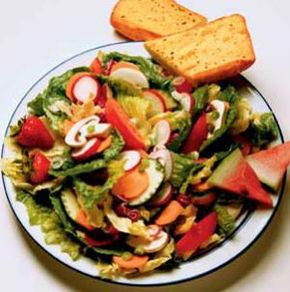Two of the three general principles -- eat fewer calories and be more active -- put forth by the USDA Dietary Guidelines have to do with calorie intake and calorie expenditure. That's because neither healthy eating nor physical activity alone can produce the most effective weight control or the greatest amount of weight loss, even though one of them may work for a while.
The Dietary Guidelines encourage you to find the balance that's right for you between calorie intake (food) and calorie expenditure (physical activity). That balance is unique to each person, and it depends on many factors, including the goal weight you set for yourself and whether you're trying to lose weight, maintain your weight, or prevent gradual weight gain over time. When we're struggling with our weight, we tend to think of calories as the bad guys. But calories are simply a way to measure energy. They shouldn't have any more of a negative connotation than do miles, which are used to measure distance. Of course, when you're on a car trip and you've got more miles left to travel than you have time or patience, then miles can seem like the bad guys. It's the same for calories. It's only when the number on the scale says that you've gained weight that calories become the enemy.
Advertisement
This article will examine the three tenets of the USDA Dietary Guidelines for calorie counting -- eating fewer calories, burning more calories, and making wise food choices. But first, let's get some more background information on calories.
A Necessary Evil
Your body needs fuel, in the form of calories from food, to sustain life. Calories are used to keep your body functioning: your heart beating, your lungs breathing, your organs working, and your brain thinking. Growing and repairing tissues requires calories, too. The number of calories your body burns to fuel these functions is called your basal metabolic rate (BMR) or metabolism. You can think of your metabolism as an engine that's idling. It burns fuel constantly to keep the car (you) running.
Your BMR accounts for about 60 to 65 percent of all your energy (calorie) expenditures. Of course, if you want to move your car, you step on the gas, which gives the car fuel to burn to power its motion.
The same is true for you. When you go off "idle" and do any physical activity, you burn more of the body's fuel in the form of calories. The more active you are, the more calories you burn. Increasing intensity, like stepping on the gas harder, increases the number of calories you burn, as does increasing the amount of time you spend doing an activity, which is akin to driving a long distance. calorie balance.
To visualize the concept of calorie balance, think of an old-fashioned balance scale with a small dish hanging from each side. The center, upright beam of the scale represents your body. The dish on the left is all of the calories that come into your body from food and beverages. The dish on the right represents all the calories you burn up in a day, including calories used for metabolism, for digesting food, and for physical activities. When you take in the same number of calories that you use up, the scale dishes are balanced, and your weight stays the same. That's what you strive for if you want to maintain your current weight. If more calories come in from food than you burn up in activity, the scale tips to the left, and you gain weight.
On the other hand, if your body uses more calories than come in from food, the scale tips to the right, and you lose weight. Weight management is simply a matter of calorie input and calorie output.
How Many Calories Are in a Pound?
Most people don't have any idea how many calories are in a pound of body weight. But that's a crucial number to know when you're trying to lose weight, and it puts all the discussion of calorie balancing and creating a calorie deficit in perspective. One pound of body weight is equal to 3,500 calories. That means that to lose one pound, you need to create a 3,500 calorie shortage by eating fewer calories, burning more calories through physical activity, or a combination of both. To gain a pound, the opposite is true: you create a 3,500 calorie surplus by eating more calories, burning fewer calories through physical activity, or a combination of both. If 3,500 calories sounds like a lot to you, it's not really.
Gaining a pound is as easy as eating 250 calories more a day (for instance 3 chocolate chip cookies or 2 ounces cheddar cheese) for two weeks or skipping a daily 250-calorie workout without cutting back on what you eat.
Being aware of your calorie intake and your calorie expenditure is one of the first steps on the path to weight control. Having calorie awareness will motivate you to make modifications in your diet. And it will also motivate you to be more physically active and to make changes in your routine that will use up more calories, such as taking the stairs at work instead of the elevator. Having calorie awareness will prompt changes that will get you to your weight-loss goal.
Now, with a firm understanding of calories and how energy balance affects your weight, you're ready to explore the next section, which focuses on how the USDA Dietary Guidelines can put you on the fast track to weight loss.
This information is solely for informational purposes. IT IS NOT INTENDED TO PROVIDE MEDICAL ADVICE. Neither the Editors of Consumer Guide (R), Publications International, Ltd., the author nor publisher take responsibility for any possible consequences from any treatment, procedure, exercise, dietary modification, action or application of medication which results from reading or following the information contained in this information. The publication of this information does not constitute the practice of medicine, and this information does not replace the advice of your physician or other health care provider. Before undertaking any course of treatment, the reader must seek the advice of their physician or other health care provider.
Advertisement




